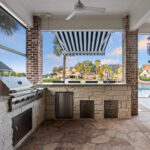When it comes to designing an outdoor kitchen, there are countless options to consider. From the layout and materials used to the appliances and fixtures, every detail plays a role in creating a functional and stylish outdoor cooking space. One popular design trend is to create a seamless transition between the indoor and outdoor kitchen areas. This can be achieved by using similar materials and colors for both spaces, as well as installing large doors or windows that can be opened to connect the two areas.
Another key element in outdoor kitchen design is the layout. It’s important to create a space that is efficient and easy to navigate, with designated areas for cooking, prepping, serving, and dining. The layout should also take into account the natural flow of the space and any existing features, such as trees or patio furniture. Consider adding an island or a bar area for additional counter space and seating options.
When it comes to materials, durability is key when designing an outdoor kitchen. Opt for materials that are weather-resistant and easy to clean, such as stainless steel, concrete, or stone. These materials can withstand the elements and are less likely to show wear and tear over time. For a cohesive look, choose materials that complement the existing landscaping and outdoor décor.
In terms of appliances, the options for outdoor kitchens continue to expand. In addition to the traditional grill and sink, consider adding a pizza oven, smoker, or outdoor refrigerator. These appliances can enhance the functionality of the space and allow for a wider range of cooking options. Be sure to also include adequate storage for utensils, cookware, and other kitchen essentials to keep the space organized and clutter-free.
Lighting is an important consideration in outdoor kitchen design, both for safety and ambiance. Install overhead lighting for cooking and dining areas, as well as task lighting for prep areas. Consider adding string lights or lanterns for a cozy, inviting atmosphere. Additionally, incorporate landscape lighting to highlight architectural features, pathways, and plants around the outdoor kitchen.
Finally, don’t forget about the finishing touches when designing an outdoor kitchen. Consider adding outdoor rugs, throw pillows, and blankets for added comfort and style. Incorporate plants and flowers to bring a touch of nature to the space. And don’t forget to include a comfortable seating area for guests to relax and enjoy the outdoor kitchen experience. With careful planning and attention to detail, you can create a beautiful and functional outdoor kitchen that will be the envy of all your friends and family.
















